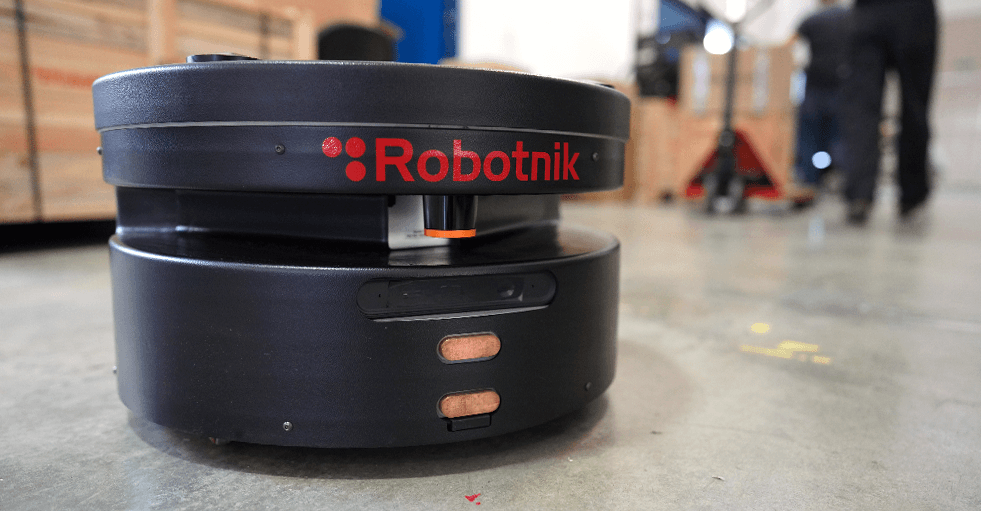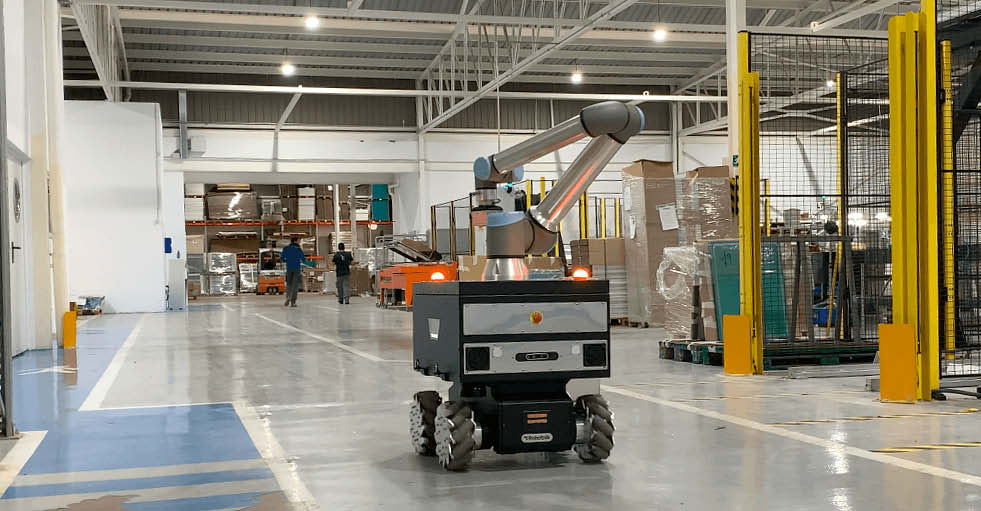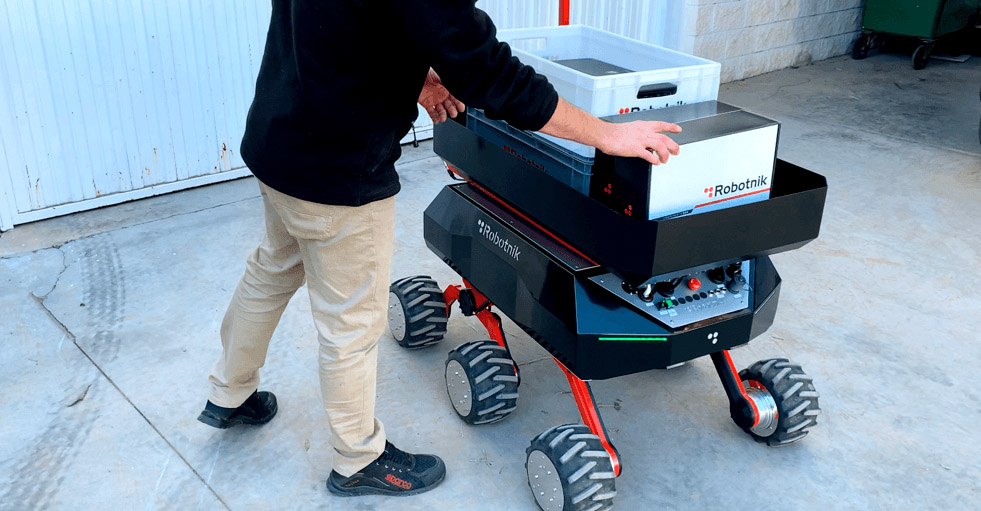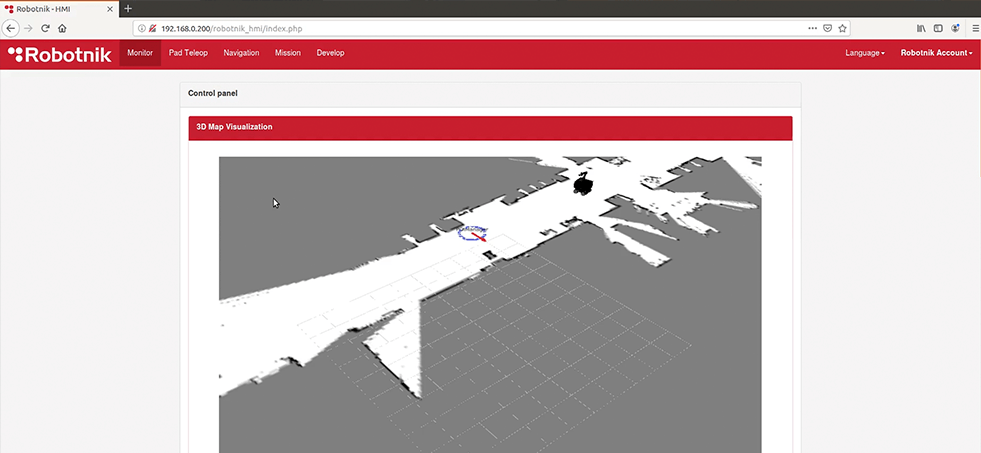-
Introduction to autonomous mobile robots and what you should consider before choosing.
-
Robotnik’s mobile robots have advantages that bring competitive value to your industry. We tell you why.
Autonomous mobile robots (AMRs) have changed the automation landscape in industry, especially in collaborative environments.
Collaborative mobile robotics is an aid in the execution of repetitive processes, adapting the movements of robots to the information they receive, process and share, as demonstrated by Robotnik’s developments.
The purpose of this post is to tell in more detail what are the advantages of Robotnik’s AMRs and how they add value to your company. At the same time, it is intended to show the real use of these devices from the perspective of a company with 19 years of experience in the sector.
Flexibility, collaboration between machines and people and diversification into new sectors and business models are setting the pace for robotics in 2021, according to the conclusions published by the International Federation of Robotics (IFR).
An autonomous mobile robot is not simply a programmed machine. An autonomous robot is one that, in addition to the initial programming, has the independence to make decisions in the working environment, without the need for human intervention. In other words, not every industrial machine is an AMR because not every machine has the capacity to make decisions based on the information it perceives (unforeseen obstacles, for example).
And how does it perceive this information? Robotnik integrates in its robots sensors, computer systems that receive, process and analyze data in real time and act accordingly.
AGV vs AMR
Although there are some similarities between the two, an AGV is not an autonomous mobile robot.
AGVs have been around since the 50s, usually for the transport of heavy loads, but they drive along a specific lane or conveyor belt and along a predetermined route. Another feature of the most advanced AGVs is that they are capable of detecting obstacles but not of re-routing: when they encounter an obstacle, they will stop.
The flexibility of AMRs to work in different locations means, for example, no change in layout, easier scalability in terms of number of units and work zones or ROI (which can be measured more easily with a smaller, later scalable project).
AMRs use free navigation by means of lasers, while the others are located with fixed elements: magnetic tapes, magnets, beacons, etc….
This means that in warehouses and places where the work environment is shared with humans, AMRs work better because of their dynamism and efficiency in sharing tasks. In addition, autonomous mobile robots have much more advanced software and hardware that provide more efficient applications.
Why has automation and collaborative mobile robotics grown so much in industry?
While this topic could be covered in another detailed article, it is important to highlight, if only briefly, some of the reasons for the boom in recent years in the introduction of AMRs in the industrial sector:
- Cost reduction
- Improved operator safety
- Increased performance and productivity
- Versatility and flexibility
- ROI – Return on Investment.
Robotnik designs, manufactures and markets autonomous mobile robots and mobile manipulators since 2002.
The wide experience in the sector makes Robotnik a reference company in mobile robotics in the world and leader in Europe.
Main advantages of Robotnik’s AMRs
Easy configuration and installation
adapting to the needs of each customer, with an open software and hardware, which allows it to adapt to the specific needs of the customer and/or the application. In the end, this translates into a quick and easy start-up.
Competitiveness
Robotnik has the best price-quality ratio in the market. Mobile robotics is no longer exclusive to large companies; many SMEs have already integrated Robotnik mobile robotics in their companies, making the leap towards Industry 4.0.
Customization
Robotnik has the ability to create and develop new prototypes that are fully adapted to customer needs. Each project requires a mobile robot with specific characteristics.
Adaptability:
thanks to the ability to make decisions, these robots carry out activities that complement, improve or replace those carried out by an operator. For a robot to be truly autonomous, must perceive and understand the environment and make decisions to operate in the most effective way, even if the environment changes or obstacles arise. In other words, autonomy gives the robot the ability to know and recognize the environment in which it is working. This gives operators greater working capacity, as they do not have to be aware of the robot.
Autonomy:
today’s AMRs cover full work shifts, allowing them to work 24/7. The robots are equipped with automatic charging stations, so they can recharge their battery autonomously when needed.
Collaborative:
One of society’s biggest concerns is how robots will transform the workplace. According to Jeff Burnstein, president at Association for Advancing Automation the trend is that “better, safer and better-paying jobs will be created thanks to robotics, as technology increases what people do best, while doing the jobs that people don’t want to do”. In this sense, the expert anticipates an improvement in public perception of robots, which will come to be seen as helpers. Collaborative mobile robots are designed to share workspace with people, ensuring their safety and performing tasks that would be repetitive, heavy or unsafe for operators.
Omnidirectional movement:
allows time reduction, making it up to 5 times faster than a differential one in a large number of tasks.
HMI (Human-Machine Interface):
Advanced user interface that allows the robot to be monitored and controlled remotely, as well as the generation and configuration of new work environments: mapping, definition of routes and waypoints. HMI functionalities are adapted to the robot capabilities, offering features such as real-time remote teleoperation, indoor and outdoor navigation handlers, creation of complex missions, and a mission scheduler system. This tool is very useful for the customer to be able to control the different operations from any device connected to the robot’s network. It is also possible to connect remotely from anywhere in the world to robots equipped with 4G/5G connectivity.
FMS:
Fleet Management System to coordinate a fleet of robots that share the same workspace and resources with the operators. The FMS user interface shows the global status of the workspace and all the deployed robots. It also provides an abstraction layer that allows users to interact with a single system. Missions, which can be generated automatically or manually, are assigned by a planning system to the most suitable robot at that moment. The system is connected to both the robot fleet and the workspace shared resources. It can monitor every mission and modify them accordingly to avoid interlocks. The FMS is able to actuate elements such as elevators, doors, or conveyors, and it can exchange information with other agents using standard communication protocols.
Mobile Robot Guide
It is aptly explained in Mobile Robot Guide: ‘Mobile robots are a unique combination of mechanical and electrical systems, together with innovative software capabilities. The basic designs of a mobile robot system are no longer rocket science. The magic now resides in the software applications which supervise a mobile robot fleet and which enable the mobile robots to perceive their world and navigate effectively and efficiently’.





